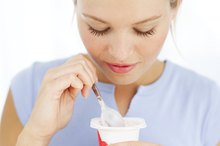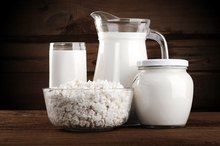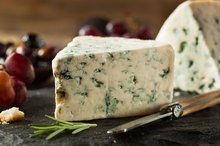How Acidic Is Yogurt?
Yogurt, a popular food made from fermented milk, owes its characteristic tangy flavor to a combination of natural acids. Probiotics, which are the "friendly" bacteria involved in yogurt production, produce these acids naturally during the fermentation process. As a result, yogurt generally has a slightly acidic pH between 4.5 and 5.0, depending on the cultures and recipe involved in its production.
Production
Yogurt-makers use a combination of natural bacteria to create the food. The most common bacteria used in yogurt-making include nonpathogenic strains of streptococcus, lactobacillus and bifidobacterium. These are different bacteria strains and species than those responsible for human diseases. When added to milk, they begin reproducing rapidly to colonize the product. This causes the milk to thicken and gain an acidic flavor. Unlike milk that has simply spoiled because of colonization with unhealthy bacteria, yogurt is both edible and nutritionally beneficial.
- Yogurt-makers use a combination of natural bacteria to create the food.
- Unlike milk that has simply spoiled because of colonization with unhealthy bacteria, yogurt is both edible and nutritionally beneficial.
Types
Food With Lactobacillus
Learn More
As friendly bacteria populate a culture of yogurt, they create several acids as a by-product of respiration and metabolism. According to the University of Guelph four major acids contribute to the taste and acidity of yogurt. These include lactic acid, acetaldehyde, acetic acid and diacetyl acid. All of these are nontoxic and contribute to yogurt's acidity to varying degrees. Depending on the exact culture used and the environment in which the yogurt was prepared, its exact amount and ratio of acids may vary.
- As friendly bacteria populate a culture of yogurt, they create several acids as a by-product of respiration and metabolism.
- All of these are nontoxic and contribute to yogurt's acidity to varying degrees.
Acidity
The acidity of yogurt can range from surprisingly acidic to relatively neutral. While some mild yogurts have a pH as high as 5.5, which is only slightly acidic, others have a low pH of about 3.0, which is extremely acidic compared to most other foods. Ordinary yogurts generally have a pH of about 4.0 to 4.5. Aside from cultures and environment, several other factors can affect the product's acidity. Alkaline ingredients such as banana and blueberry may raise yogurt's pH, while acidic ingredients such as orange and sugar may lower it.
- The acidity of yogurt can range from surprisingly acidic to relatively neutral.
- Alkaline ingredients such as banana and blueberry may raise yogurt's pH, while acidic ingredients such as orange and sugar may lower it.
Effects
Is the Good Bacteria in Activia Yogurt in All Yogurts?
Learn More
Yogurt's acidity contributes to many of its culinary and health effects. The acids in yogurt give it the sharp flavor that separates it from other dairy products. The acidic compounds produced by "friendly" bacteria can also contribute to their health benefits, which, according to the National Institutes of Health, may include digestive health, yeast defense and immune support. More studies are needed to evaluate the exact benefits associated with acidic yogurts compared to those with a more neutral pH.
- Yogurt's acidity contributes to many of its culinary and health effects.
- More studies are needed to evaluate the exact benefits associated with acidic yogurts compared to those with a more neutral pH.
Related Articles
References
- University of Guelph: Yogurt and Other Fermented Milk Products
- National Institutes of Health: Lactobacillus
- Routray W, Mishra H. Scientific and Technical Aspects of Yogurt Aroma and Taste: A Review. Wiley. 2011. doi:10.1111/j.1541-4337.2011.00151.x
- How to read food labels. MedlinePlus. U.S. National Library of Medicine. 2018.
- S.C. Ziesenitz. Authorised EU health claim for fructose in Foods, Nutrients and Food Ingredients with Authorised EU Health Claims: Volume 2. Woodhead Publishing Series in Food Science, Technology and Nutrition. 2015; 189-215. doi:10.1016/B978-1-78242-382-9.00011-6
- Isik U, Boyacioglu D, Capanoglu E, Erdil DN. Frozen yogurt with added inulin and isomalt. J Dairy Sci. 2011;94(4):1647-56. doi:10.3168/jds.2010-3280
- Yogurt, coconut milk. USDA FoodData Central. Updated April 1, 2020
- Gambelli L. Milk and Its Sugar-Lactose: A Picture of Evaluation Methodologies. Beverages. 2017;3(3): 35. doi:10.3390/beverages3030035
- Yogurt. Harvard T.H. Chan School of Public Health.
- Muth N. The truth behind the Greek yogurt craze. American Council on Exercise.
- Are all yogurts created equal? Not exactly, a nutritionist says. Kansas State University Agricultural Experiment Station and Cooperative Extension Service. 2013.
- Goldberg J MD, O’Mara K. The Four Corners Diet: The Healthy Low-Carb Way of Eating for a Lifetime. Da Capo Press. 2004.
- Goldberg J, OMara K, Becker G. The Four Corners Diet: The Healthy Low-Carb Way of Eating for a Lifetime. New York: Marlowe; 2009.
- National Yogurt Association. Live and Active Culture (LAC) Yogurt FAQ's.
- USDA. National Nutrient Database for Standard Reference Release 28.
Writer Bio
Juniper Russo, an eclectic autodidact, has been writing professionally since 2008. Her work has appeared in several online and print-based publications, including Animal Wellness. Russo regularly publishes health-related content and advocates an evidence-based, naturopathic approach to health care.









